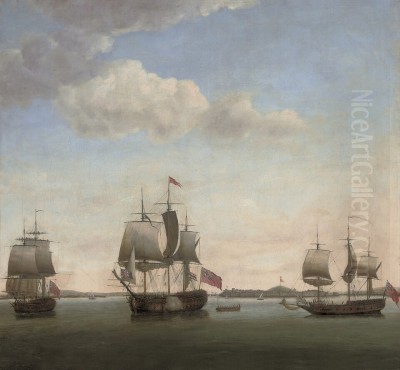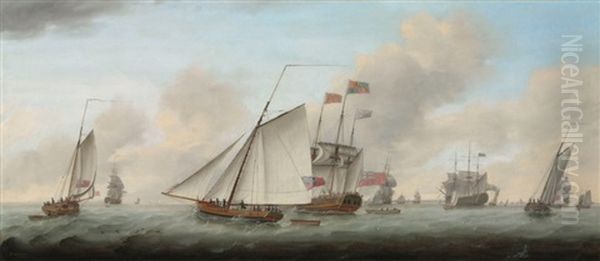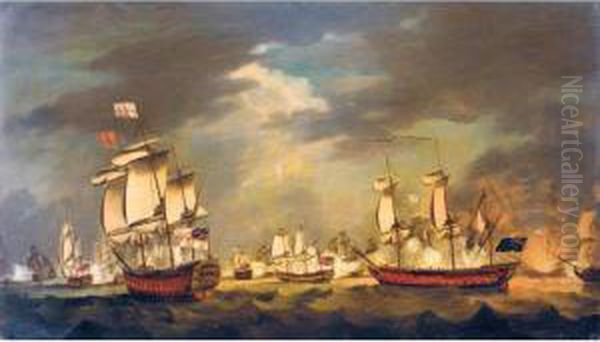
Francis Holman (1729-1790) stands as a significant, if sometimes overlooked, figure in the rich tradition of British marine painting. Flourishing in an era when Great Britain's maritime power was reaching its zenith, Holman's work captured the essence of naval life, the majesty of sailing ships, and the dramatic intensity of the sea. His meticulous attention to detail and profound understanding of his subject matter have ensured his enduring appeal, with his paintings now highly prized by collectors and institutions alike.
Early Life and Maritime Immersion
Born in Ramsgate, Kent, near St. Mary's Church, Francis Holman was immersed in a maritime environment from his earliest days. Baptized on November 14, 1729, he was the son of a ship's captain, a master mariner, and the grandson of a carpenter. This familial connection to the sea and shipbuilding undoubtedly provided him with an intimate, firsthand knowledge of vessels and seafaring life. Such a background was invaluable for an artist aspiring to specialize in marine subjects, allowing him to depict ships with an accuracy that resonated with those who knew them best.
His upbringing in a bustling port town like Ramsgate would have exposed him daily to the sights and sounds of the maritime world: the intricate rigging of ships, the varying moods of the sea, and the activities of sailors and dockworkers. This early immersion is evident in the authenticity that pervades his canvases. While specific details of his early artistic training remain somewhat obscure, it is clear that his practical understanding of ships formed a crucial foundation for his later artistic endeavors.
Artistic Development and Signature Style
Francis Holman's artistic career began to gain public recognition in the 1760s. He initially exhibited with the Free Society of Artists between 1767 and 1772, showcasing his burgeoning talent. His early works often focused on detailed "ship portraits"—commissions from captains or owners who wished to have a faithful representation of their vessel. These pieces required not only artistic skill but also a draughtsman's precision in rendering the specific features of each ship.

As his career progressed, Holman's thematic range expanded. He moved towards more dynamic and often patriotic subjects, including depictions of the Royal Navy, fleet maneuvers, and dramatic sea battles. This shift coincided with a period of significant naval activity for Britain, including the American War of Independence, providing ample inspiration and demand for such works. His style is characterized by a remarkable clarity, meticulous attention to nautical detail – from the complex rigging to the construction of the hulls – and a keen observation of atmospheric effects. He was adept at capturing the play of light on water and the subtle gradations of the sky, lending a convincing realism to his scenes.
Holman's treatment of water, particularly waves, was often noted for its accuracy and dynamism. He managed to convey both the power and the beauty of the sea, whether depicting a calm, reflective surface or the turbulent chaos of a storm. His compositions are generally well-balanced, often employing a low horizon line, which emphasizes the vastness of the sky and the sea, a characteristic also seen in the work of earlier Dutch masters like Willem van de Velde the Elder and Willem van de Velde the Younger, whose influence on British marine painting was profound.
Exhibitions and Recognition
A significant period in Holman's career involved his association with the Royal Academy of Arts in London. He exhibited a substantial number of works there, with records indicating as many as seventeen paintings shown between 1774 and 1778, and further exhibitions extending up to 1784. The Royal Academy, founded in 1768 with Sir Joshua Reynolds as its first president, was the premier venue for artists to display their work and gain recognition. Holman's consistent presence there underscores his standing within the contemporary art scene.
Despite his active exhibition record and the evident quality of his work, Francis Holman did not achieve widespread fame during his lifetime, at least not to the extent of some of his contemporaries like Dominic Serres, who held the title of Marine Painter to King George III, or Charles Brooking, whose tragically short career produced works of exceptional quality. However, the enduring appeal of Holman's paintings lies in their honesty and technical proficiency. In the centuries since his death, his work has been increasingly appreciated, and his paintings are now sought after by collectors of maritime art, gracing public and private collections worldwide.
Notable Works and Thematic Concerns
Francis Holman's oeuvre encompasses a variety of maritime subjects. Among his representative works, several titles illustrate the breadth of his interests:
The Augusta Yacht: Yachting scenes were popular, and this work likely depicts a specific vessel, showcasing his skill in ship portraiture.
A Fleet Saluting the King: This type of ceremonial scene allowed for grand compositions featuring multiple vessels and often celebrated royal occasions or naval power.

The Chase: Depicting naval pursuits, these paintings captured the drama and tension of maritime conflict or pursuit of merchantmen by privateers.
A Calm: Contrasting with his more dramatic scenes, paintings of calm seas demonstrated his ability to render tranquil waters and reflective light, a subject also masterfully handled by artists like Peter Monamy.
A Shipwreck near the Head of a Beach: Shipwrecks were a popular and dramatic theme in marine art, allowing artists to explore the power of nature and human vulnerability, a subject that would later be taken to sublime heights by J.M.W. Turner.
The Victory Sailing from Sheerness: Depicting famous naval vessels like HMS Victory was a common practice, appealing to patriotic sentiment and interest in the Royal Navy.
A Surprise and A Combat: These titles suggest scenes of naval engagement, showcasing his ability to render the chaos and action of sea battles, a genre also popularised by artists like Nicholas Pocock and Robert Dodd.
His works often featured specific, identifiable vessels, indicating that many were likely commissions. The accuracy of his ship depictions was paramount, suggesting a clientele that included naval officers, ship owners, and merchants who valued such fidelity. He was particularly skilled in portraying the subtle variations in light and weather, from the clear light of a calm day to the brooding atmosphere of an impending storm.
Influence and Artistic Connections
One of Francis Holman's most significant contributions to the lineage of British marine painting was his role as a teacher. He is credited with having taught Thomas Luny (1759-1837), who went on to become a prolific and highly regarded marine painter in his own right. Luny's early works, in particular, show a strong stylistic resemblance to Holman's, especially in the handling of waves and the characteristic low horizon lines. This master-apprentice relationship ensured the continuation of certain stylistic traits and a commitment to nautical accuracy.

Holman worked within a vibrant community of marine artists in London. Besides those already mentioned, figures like John Cleveley the Elder and his son John Cleveley the Younger were also active during this period, contributing to the diverse output of maritime art. Samuel Scott, though often known for his views of the Thames, also produced significant marine paintings. The collective work of these artists created a comprehensive visual record of Britain's maritime life and naval prowess during the 18th century. Holman's contribution, with its emphasis on detailed realism, provided a distinct voice within this chorus. The influence of earlier Dutch masters, such as Ludolf Bakhuysen, can also be discerned in the broader school of British marine painting, particularly in the dramatic portrayal of stormy seas.
The Broader Context: 18th Century British Marine Art
To fully appreciate Francis Holman's work, it is essential to consider the context of 18th-century Britain. The nation was a dominant global maritime power, with a vast colonial empire, extensive international trade, and a formidable Royal Navy. This maritime supremacy fostered a strong public interest in naval affairs and seafaring. Marine painting, therefore, was not merely an aesthetic pursuit but also served to document, celebrate, and promote Britain's achievements at sea.
The demand for marine paintings came from various quarters: the Admiralty commissioned depictions of naval battles and ship launches; naval officers and ship owners desired portraits of their vessels; and merchants involved in maritime trade also patronized marine artists. This environment provided ample opportunities for specialists like Holman. His focus on accuracy would have been particularly valued by those with direct experience of the sea. Artists like Richard Paton also catered to this demand, often depicting specific historical naval engagements. The tradition continued and evolved with later artists such as Clarkson Stanfield in the 19th century, who brought a more Romantic sensibility to marine subjects.
Holman's career spanned a period of significant artistic development in Britain. The establishment of institutions like the Society of Artists and the Royal Academy provided platforms for artists to exhibit their work and engage with a wider public. While landscape painting, championed by artists like Richard Wilson and Thomas Gainsborough, and portraiture, dominated by figures like Reynolds and Romney, often took center stage, specialized genres like marine painting carved out a significant niche.
Personal Life and Later Years
Details about Francis Holman's personal life, beyond his maritime lineage, are somewhat sparse, as is common for many artists of his era who did not achieve superstar status. It is known that he married Anne Long, and together they had three children. Later research indicates he may have been married twice. His first wife was possibly Elizabeth, with whom he had three children, though two reportedly died in infancy. His second marriage may have been to Jane Maxted, with whom he had two sons, though they seem to have left no descendants.
Holman resided in various locations in London throughout his career, often in areas closely associated with maritime activity. He lived in Wapping and Shadwell, districts along the Thames heavily populated by sailors, shipbuilders, and others connected to the port. In his later years, he is recorded as living in Ratcliffe Highway, another area with strong nautical connections. These choices of residence likely kept him close to his subjects and patrons, allowing him to continually observe the ships and river life that formed the core of his artistic output.
He continued to paint into his later years, maintaining his commitment to detailed and accurate depictions of the maritime world. Francis Holman passed away in 1790, at the age of 61.
Legacy and Conclusion
Francis Holman's legacy is that of a dedicated and highly skilled marine painter who made a significant contribution to this specialized genre in British art. While he may not have enjoyed the same level of contemporary fame as some of his peers, the intrinsic quality of his work—its meticulous detail, profound understanding of naval architecture and practice, and ability to capture the varied moods of the sea—has ensured its lasting value.
His paintings serve as important historical documents, offering insights into the ships, naval practices, and maritime environment of 18th-century Britain. They are a testament to an era when the sea was central to the nation's identity and prosperity. Furthermore, his role as a teacher, particularly to Thomas Luny, helped to perpetuate a tradition of skilled marine artistry.
Today, Francis Holman's works are appreciated for their aesthetic merit and historical significance. They are found in major maritime museums and art collections, where they continue to engage viewers with their faithful and evocative portrayals of the age of sail. He remains a key figure for anyone studying the development of British marine painting, an artist whose dedication to his craft produced a body of work that is both informative and visually compelling, securing his place in the annals of art history.